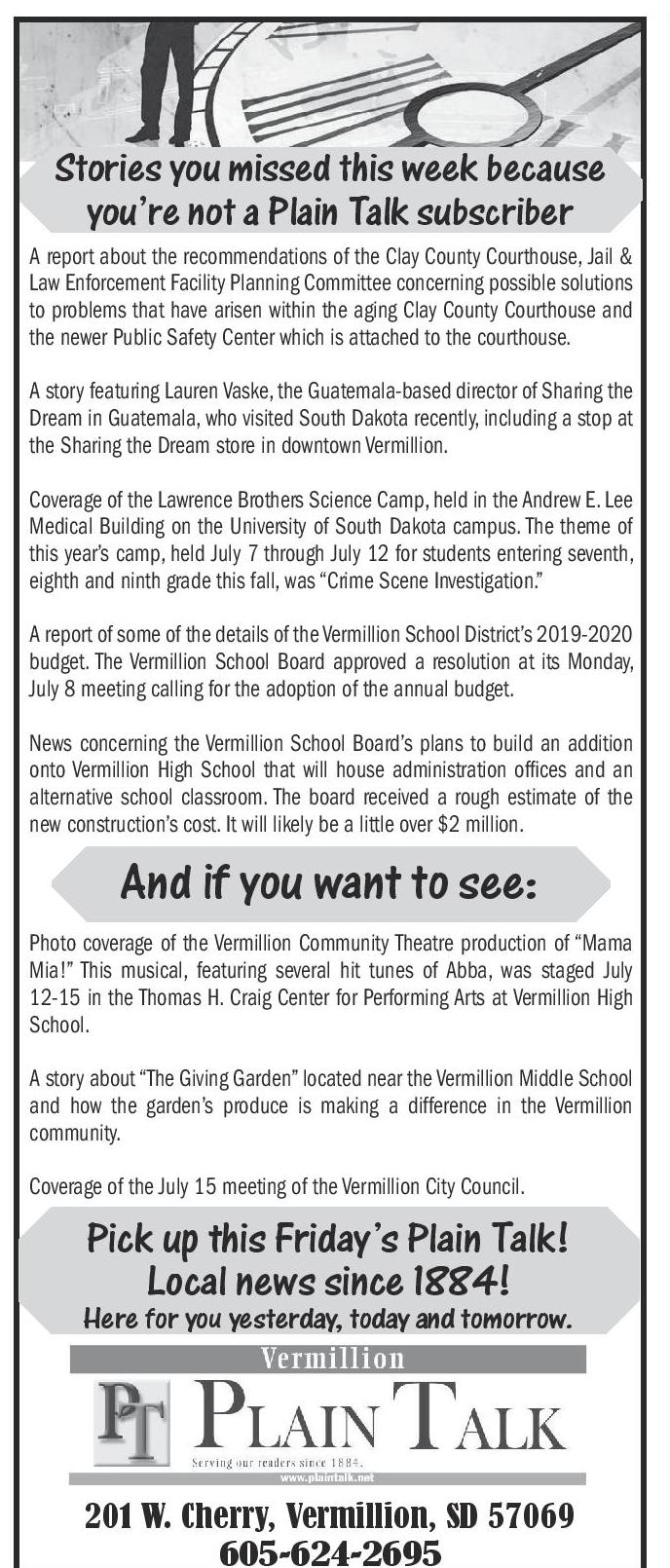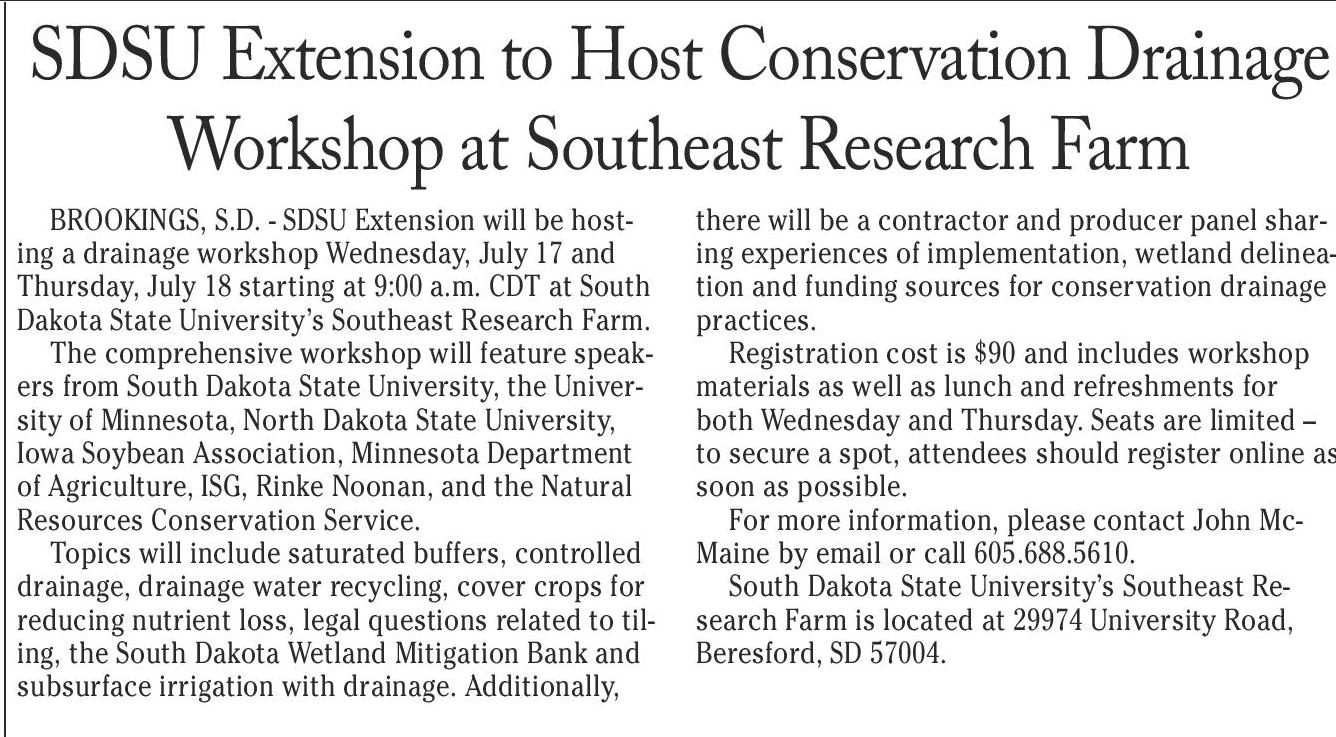071619_YKBP_A7.pdf





Broadcaster Press 7
July 16, 2019 www.broadcasteronline.com
Cover Crops 2019 - What to Plant When
BROOKINGS, S.D. - As many Midwest
producers look to cover crops to build
soil health and/or provide supplemental
forage after a soggy spring, many questions are arising regarding management
decisions, specifically species selection
and planting timing.
There is no ‘hard and fast’ blanketed mix that can be recommended
to all producers, as each grower is in
a unique circumstance with different
production environments, soil types
and management techniques. Rather
than seeking the ‘go-to’ mix of your
neighbor’s choosing, ask yourself a few
fundamental questions before planting
a cover crop. Below are some of the
critical questions producers should
consider before planting cover crops on
prevent plant acres this season.
Herbicide history. Consider your
crop rotation as well as haying/chopping and grazing restrictions of herbicides previously applied; this includes
herbicides applied before planting
cover crops this season, as well as
those applied in the previous season.
This is a key component to having a
successful cover crop. For more considerations regarding herbicide carryover
click here.
Insurance and Farm Service
Agency (FSA) Guidelines. Be sure to
check with your insurance agent and
FSA representative on all details regarding the seeding of your cover crop. The
prevent plant harvest date for mechanical forage harvest and/or grazing has
been changed to September 1 for 2019.
Frequently asked questions and answers regarding insurance can be found
on the Risk Management Agency (RMA)
website.
Purpose. Always begin with the
end in mind. Soil health, weed suppression, nutrient capture, soil moisture
management, additional harvested forage and grazing may all be common reasons to plant a cover crop. Try focusing
on your own objectives when creating
a planting plan. The SD Cover Crop
Poster lists most common South Dakota
cover crops and their purpose ratings,
seeding rates and seeding depths.
Seed availability and price. As
cover crop seed is in high demand this
year, the seed of some popular forage
cover crop species could be in scarce
supply and may have risen in price,
which are important factors to consider
before choosing a mix. Although most
producers want to keep costs low, it
should be kept in mind that forage
crops and/or improved soil health does
come at a price and some investment
will be necessary.
Crop rotation. Keep your previous crop and intended crop for 2020
in mind; it is generally recommended
to plant cover crops of diverse growth
habit to the subsequent cash crops, i.e.,
primarily broadleaves prior to grass
cash crops and vice versa.
Termination. In most cases, many
cover crops will winter kill. However,
some species may over-winter such as
cereal rye, winter wheat, triticale, etc.
Additionally, some seed, such as some
ryegrass and vetch, can stay dormant
for a prolonged period (hard seed).
This does not eliminate these crops as
an option; it simply requires prompt
Buying or
Selling Oats
for a Cover
Crop?
BROOKINGS, S.D. - As a challenging row crop
planting season finally wraps up for 2019 in South
Dakota, many producers are looking to plant cover
crops on unplanted acres to provide forage, control
weeds, reduce erosion and improve soil health. One
popular cool-season grass cover crop is oats. Most
oats in South Dakota are grown as certified varieties
and it is important to be aware of the legal ramifications behind purchasing oat seed for use as a cover
crop.
The South Dakota Crop Improvement Association (SDCIA) focuses on the “delivery of research
through the release of public crop varieties;” this
includes support of the South Dakota State University small grain breeding programs. Specifically,
the SDSU Oat Breeding Program has released many
successful commercially available varieties over the
last several years including: Goliath, Hayden, Horsepower, Shelby 427 and Natty. In order to continue
the development of locally adapted varieties of oats
and other small grains for years to come, royalties
must be associated with variety releases. Royalties
provide funding for equipment, research and land
usage/rental.
When a variety is released from SDSU through the
SDCIA, it is protected by ‘Plant Variety Protection
with Title V’ (PVP). This requires that the variety be
sold as seed by the official variety name as a class
of certified seed. Put simply, this means it is not
legally permissible for private farmers or elevators/
coops to sell protected varieties as grain for seeding
purposes (including cover crops) unless said variety
was grown or purchased as a protected, named variety. Therefore, farmers cannot sell ‘bin-run’ (SDSU
bred) oats to one another legally, as this is technically grain, not a protected, named seed variety.
However, it is legally permissible for a grower to
plant their own bin-run grain as seed as long as it
was grown on their farm.
In addition to following PVP regulations, purchasing quality seed is an important part of protecting
South Dakota growers from the introduction of new
weed and pest issues. When purchasing any seed, it
is important to check seed tags for weed seed levels;
this is especially true when working with cover
crops. Growers should always check to be sure seed
has been cleaned and tested for weed seed, disease,
and inert matter. Palmer amaranth is an example of
a weed that was inadvertently introduced into South
Dakota by producers purchasing and growing lowquality seed.
As of late, variety infringement has been more
readily enforced in South Dakota in an effort to
protect both seed integrity and funding for SDSU
breeding programs. Recently a ‘Plant Variety Protection’ case was settled in Iowa for $2.975 million; this
lawsuit involved SDSU oat varieties that were being
illegally sold as part of a cover crop mixture. This
information is being provided as a protection tool
for South Dakota growers and businesses, as many
may be unaware of regulations surrounding the buying and selling of oats in South Dakota. South Dakota
grown seed is a great asset to our agricultural sector
and royalties from the sale of protected varieties
are a vital part of keeping our breeding programs
alive. Please feel free to contact the SDCIA office at
605.688.4606 with any PVP-related questions.
spring attention and management, as
these crops may be of great value to
utilize excess moisture in a potentially
wet spring.
Weed Control. Often times, if a
diverse cover crop mix is planted, it
is nearly impossible to chemically
control weeds during the growth of
the cover crop. If a mix is well-planned
and grown under ideal growing conditions, weed control typically is not an
issue. However, if a particular weed is
of concern, this should be considered
before selecting cover crops. Winter rye
is known for its inherent allelopathic
characteristics, i.e. its ability to suppress weeds by the production of a
biological chemical substrate that is
harmful to other surrounding species.
However, other grasses such as sprawling or more ground covering broadleaf
crops (such as vetches, or radish and
turnip) can aid in weed suppression by
keeping soils covered.
Soil Fertility. If a producer intends
to use a cover crop as forage, nitrogen
application may be required. Consider
previous crop credits and current soil
test levels if legumes were planted. In
many situations, low nitrogen application rates (30-60lbs/a) will provide considerable growth for cover crops. It is
important to apply the appropriate rate
of nitrogen when planting for forage
purposes to avoid nitrate buildup in the
plant, which may cause toxicity to animals. Check the South Dakota Fertilizer
Recommendations Guide for suggested
soil fertility guidelines for major South
Dakota crops.
Planting time. As most cover crops
are grown in blends, it is difficult to establish an exact seeding date based on
individual crop species. However, there
are suggested planting timing windows
for crop types based on the proportion
of different cover crops species in the
blend. Cool season cover crops such as
small grains, peas, clovers, vetch and
brassicas should be planted during or
near the third week of July, as average
daily temperatures tend to decrease
due to lower night temperatures, which
creates a better growing environment
for cool season species. On the other
hand, warm season species (forage
sorghums, sorghum-sudangrass, buckwheat, sunflower, and teff grass, etc.)
can be planted prior to the third week
of July, but ideally no later than the first
week of August. Typically, these crops
are planted in June, but delayed and
prevented planting of row crops may
have predetermined an early July planting. When planted within these suggested guidelines, cover crops should
have ample growth to be harvested for
forage after September 1. Due to growth
habit, some species in the mix may
mature faster than others, which should
not inhibit forage harvest.
Although there are many factors to
take into consideration, cover crops
can be an excellent tool to mitigate
the challenging planting season. Cover
crops not only reduce fallow acres, but
also enhance soil health and provide
supplemental forage. For more information, contact your nearest SDSU Extension Regional Center or local NRCS
office for cover crop recommendations
and other assistance.
SDSU Extension to Host Conservation Drainage
Workshop at Southeast Research Farm
BROOKINGS, S.D. - SDSU Extension will be hosting a drainage workshop Wednesday, July 17 and
Thursday, July 18 starting at 9:00 a.m. CDT at South
Dakota State University’s Southeast Research Farm.
The comprehensive workshop will feature speakers from South Dakota State University, the University of Minnesota, North Dakota State University,
Iowa Soybean Association, Minnesota Department
of Agriculture, ISG, Rinke Noonan, and the Natural
Resources Conservation Service.
Topics will include saturated buffers, controlled
drainage, drainage water recycling, cover crops for
reducing nutrient loss, legal questions related to tiling, the South Dakota Wetland Mitigation Bank and
subsurface irrigation with drainage. Additionally,
there will be a contractor and producer panel sharing experiences of implementation, wetland delineation and funding sources for conservation drainage
practices.
Registration cost is $90 and includes workshop
materials as well as lunch and refreshments for
both Wednesday and Thursday. Seats are limited –
to secure a spot, attendees should register online as
soon as possible.
For more information, please contact John McMaine by email or call 605.688.5610.
South Dakota State University’s Southeast Research Farm is located at 29974 University Road,
Beresford, SD 57004.
ESTATE
AUCTION
Stories you missed this week because
you’re not a Plain Talk subscriber
A report about the recommendations of the Clay County Courthouse, Jail &
Law Enforcement Facility Planning Committee concerning possible solutions
to problems that have arisen within the aging Clay County Courthouse and
the newer Public Safety Center which is attached to the courthouse.
A story featuring Lauren Vaske, the Guatemala-based director of Sharing the
Dream in Guatemala, who visited South Dakota recently, including a stop at
the Sharing the Dream store in downtown Vermillion.
Coverage of the Lawrence Brothers Science Camp, held in the Andrew E. Lee
Medical Building on the University of South Dakota campus. The theme of
this year’s camp, held July 7 through July 12 for students entering seventh,
eighth and ninth grade this fall, was “Crime Scene Investigation.”
A report of some of the details of the Vermillion School District’s 2019-2020
budget. The Vermillion School Board approved a resolution at its Monday,
July 8 meeting calling for the adoption of the annual budget.
News concerning the Vermillion School Board’s plans to build an addition
onto Vermillion High School that will house administration offices and an
alternative school classroom. The board received a rough estimate of the
new construction’s cost. It will likely be a little over $2 million.
And if you want to see:
Photo coverage of the Vermillion Community Theatre production of “Mama
Mia!” This musical, featuring several hit tunes of Abba, was staged July
12-15 in the Thomas H. Craig Center for Performing Arts at Vermillion High
School.
A story about “The Giving Garden” located near the Vermillion Middle School
and how the garden’s produce is making a difference in the Vermillion
community.
Coverage of the July 15 meeting of the Vermillion City Council.
Pick up this Friday’s Plain Talk!
Local news since 1884!
Here for you yesterday, today and tomorrow.
Saturday, July 20, 2019
Sacred Heart Parish Hall — Wynot, NE
AUCTION Starts @ 9:30 AM
Lunch Available
AUCTIONEERS NOTE: Join us for this nice Estate Auction in Wynot,
Nebraska on Saturday, July 20th. Visit our Website www.
CHJAUCTIONEERS.COM for several photos for this Auction.
APPLIANCES: Maytag Smooth Top Range, Stainless. Maytag Microwave, Black. Whirlpool Built In dishwasher, Black. GE Refrigerator,
22.5 cu ft. 13’ Gibson Freezer. International Harvester Refrigerator.
Whirlpool Washer. Philips TV. Coby Flat Screen TV. Whirlpool Apartment Refrigerator. Kirby Vacuum Cleaner. Fantom Vacuum Cleaner.
Westinghouse Electric Roaster. Hotpoint Dorm Refrigerator. Bose Radio. Eden Pure Room Heater. Panasonic TV. Power Rider Exerciser.
Schwinn Exercise Bike. FURNITURE: Lighted Curio Cabinet. Dining
Room Table w/4 chairs & 4 leaves. Dresser with Mirror (2). Dresser
with Mirror and Stool. Queen Bed w/Mattress & Box Spring. Chest
of Drawers. 2 Piece Bedroom Set. Drop Leaf Table. Sofa Table. End
Tables. Blue Loveseat. 5-Drawer Chest of Drawers. Several Parlor
Tables. Queen Bed. 2-Beige Charles Snyder Recliners. Day Bed. Dining Room Table w/6 chairs & 2 leaves. Office Chair. Round Pine Table
w/4 stuffed Chairs. Hall Tree (nice). 5 Bar Stools. Burgundy Recliner.
Floral Sofa. Teal Recliner. 4 Kitchen Chairs on Rollers. Bed Spring
& Mattress. Double Chair Patio Rocker. MISCELLAENOUS: Card
Tables & Chairs-round & square. Steel Wardrobe. Luggage. Plant
Stand. Clocks and Wall hangings. JD 3010 Toy Tractor. Floor Lamps.
Dresser Lamps. Fan. Bookshelf. Sears Electric Typewriter. Leather
Purses. Floor Polisher/Sander/Buffer. Pictures. Mirrors. Shelving
Units. Night Stand. Centry Safe. Crucifixes. Western Boots Size 10.
Tablecloths and Linens. Bedding. Cassette Tapes. Metal Filing Cabinets. Pressure Cookers-new. Brooms. Garden Hose. Lawn Chairs.
Lawn Sprinklers & Ornaments. Fishing Poles. Formica CounterTop
63x36. Christmas Decorations. Pots & Pans. Tupperware & Glassware. MOWERS & GARDEN EQUIPMENT: 2016 JD Tractor Mower,
D130, 22 HP, 64 hours, 38” w/bagger. Parmi Tiller, 2 HP, Briggs &
Stratton Engine. Char Broil Gas Grill. Craftsman Air Compressor. 2
Wooden Step Ladders. Aluminum Extension Ladder. Fiberglass Step
Ladder. Plastic Folding Picnic Table. Floor Jacks. Craftsman Socket
Set. Craftsman ½” Drill. Hornet Electric Chain Saw. Weed Eater. Oil
Pans. Coolers. Air Tank. Gas Cans. Saw Horses. 2-Wheel Cart. Skill
Table Saw. Craftsman Tool Box. Black n Decker Miter Saw. Many Hand
Tools. ANTIQUES & COLLECTIBLES: High-Boy Dresser w/Mirror
– Serpentine Front. 2 Antique Dressers. Antique Saddle. Veterinary
Books from late 1950’s. Centennial Dress and Umbrella. Stuffed Red
Chair. 4 Wooden Chairs. Kerosene Lamp. Jewelry Boxes & Jewelry.
Belt Buckles, Tokens, Tie Tacs. Teamster Wrist Watch. Singer Sewing
Machine. Office Desk. Philco Radio/Record Player. 8 Track Tapes.
Wynot Centennial Crock Bowl. Crocheted Rugs. Butcher Block Table.
Enamel Coffee Pot. Canners. One Gal. Salt Glazed Crock. 2 Gal. Red
Wing Crock. Apple Baskets. Galvanized Milk Buckets. Tapestry. Fruit
Jars. Antique Step Stool. Many Western Pictures and Memorabilia.
Bachmann EZ Electric Plastic Train Set. Panasonic Radio Entertainment Center. Truck Wall Hanging. Poker Table. Storz Aluminum
Cooler. Meat Hooks. Diamond Willow Walking Stick. 3-Burner Cast
Iron Skillet. 2 Ornate Windows. Tonka Steel Dune Buggy. Straw & Felt
Western Hats, 7 1/8. Western Cowboy Bust. Records.
MAURICE & DIANE WUEBBEN ESTATE
201 W. Cherry, Vermillion, SD 57069
605-624-2695
SEE www.CHJAUCTIONEERS.COM FOR LISTING & PHOTOS
Terms: Cash or Bankable Check. Not Responsible For Accidents or Theft.
AUCTION CONDUCTED BY:
CREAMER HEIMES JANSSEN AUCTIONEERS & APPRAISERS L.L.C.
Hartington, NE — RYAN CREAMER 402.254.9753
ALTON HEIMES 402.254.3315 ROGER JANSSEN: 402.388.4409














 Previous Page
Previous Page






